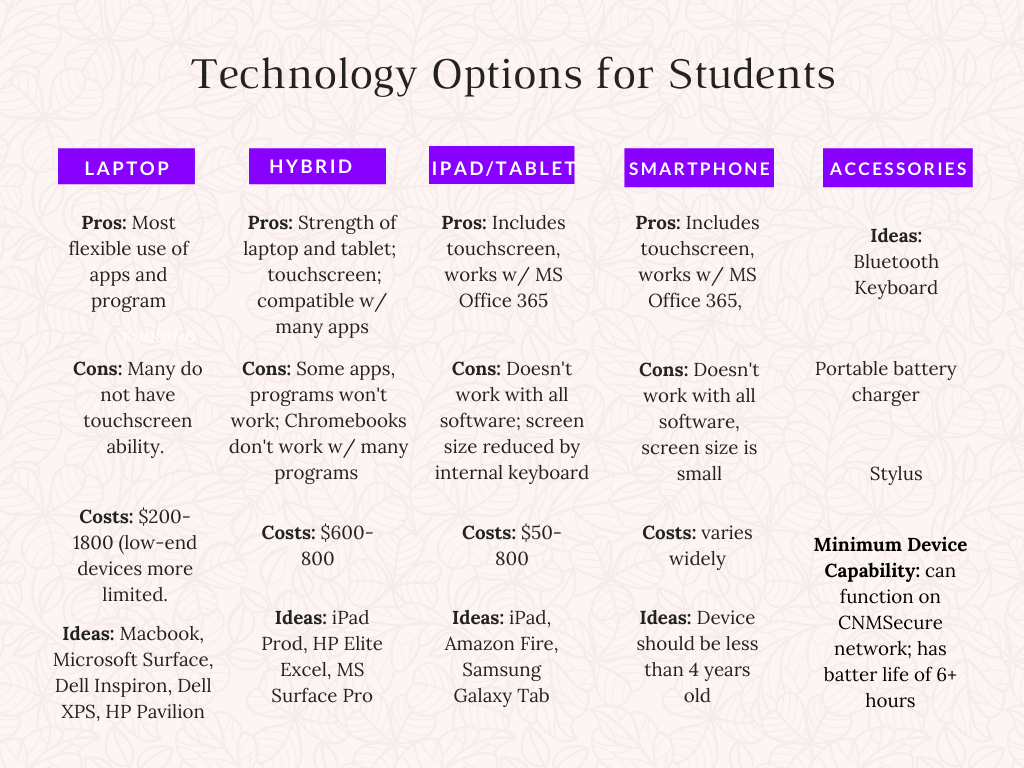eBooks Basics
An eBook/eTextbook is a digital book that is read on an electronic device like a smartphone, iPad/tablet, laptop, or desktop computer. Many digital books can be printed, but doing so increases how much they cost AND loses all the benefits of using a digital book.
Why would you want to use an eBook instead of a printed book?
- eBooks/eTextbooks are usually significantly cheaper than traditional hardcopy books. In many cases, if the eBook is an OER, you obtain the book for FREE.
- Can usually obtain a download of the book immediately. No waiting for out-of-stock books or shipping time.

Figure 1: Image by Pexels from Pixabay - You can use your eBook offline and without wifi after it is downloaded.
- Hard to lose. If you do lose your smartphone or laptop you can download the book again on a new device.
- Carrying several eBooks on your smartphone is MUCH LIGHTER than carrying several hardcopy textbooks.
- You can typically share between multiple devices. For example, you can go back and forth between your smartphone and laptop.
- More environmentally friendly.
- Features that Enhance Student Learning:
- Integrated (immediate) dictionaries, glossaries, and other types of multimedia hyperlinks
- Self-study tools
- Adaptive learning and quizzing features that are immediate as you use your eBook
- Easier to search for information – like “Googling” within the eTextbook
- Increased accessibility features or assistive technologies like text-to-voice, voice-to-text, screen readers (magnifiers), among other possibilities.
How do you Read an eBook
EBooks come in different formats and, depending on the format, are used with different apps. At CNM, our Open Educational Resources (OERs) are distributed in a few different formats depending on the needs of a course: html (view online in your web browser), pdf document, and/or MS Word document. CNM OERs released in html or MS Word formats can be converted or downloaded as pdf documents and used in any pdf reader app or note-taking app (e.g., OneNote, Kindle, PDF Viewer, Foxit, etc).
Most OERs published by other organizations can be used in the same apps as the CNM produced OERs. Large non-profit organizations may also provide their OERs in formats that can be downloaded in Amazon Kindle™ or iBooks™ formats.
Large for-profit publishers like Elsevier, McGraw-Hill, Morton, Pearson, and Wiley typically offer their eTextbooks in a format that requires you to use their proprietary eBook reader app or adaptive book eReader. Examples include ReadAnywhere™, SmartBook™, and Bookshelf™. Some are also available for download into the Amazon Kindle™ app which can be used on any mobile device or desktop computer.
Common functions available for most eBooks:
- Notetaking
- Highlighting
- Underlining
- Textbox comments
- Table of Contents, Glossary,
- Rich Media: hyperlinks to websites, videos, audios, etc
- Search box
- Bookmarks
- Change colors, brightness, and background shading for readability
- Audio readers – text-to-speech
Additional Functions available in some eBook readers or PDF readers:
- Digital note writing using a stylus (also called digital annotation or inline annotation)
- Syncing of notes/highlights between mobile electronic devices
- Flashcard builders
- Dictionary and other Reference book features
- Foreign language ePacks/translators
- Downloading and/or sharing of notes via email or Cloud servers like Dropbox and Google Docs
- Social Elements (e.g., reviews, opinions, bookclubs)
What Types of Devices Can You Use to Read eBooks and eTextbooks?
An eBook/eTextbook can be used on any type of electronic, computing device. Devices include smartphones, tablets/iPads, laptops, and desktop computers. What device you use depends on what you have, what you can afford, and how you want to use the eBook and/or study.
Smartphone:
A modern smartphone has the same computing power as most laptop computers. Ebooks typically work very well on smartphones.
Pros
- Touchscreen
- Small, portable
- Always have it with you
- Most students already own one
Cons
- Smaller screen
- Battery life
- May not work with all apps
Tablet or iPad
Digital books work well on tablets and iPads. An advantage of the tablet and iPad are the touchscreen features and screen size that is larger than a smartphone.
Pros
- Touchscreen
- Light and portable
- Larger screen
Cons
- Heavier than smartphone
- Battery life
- May not work with all apps
Laptop
Digital books work well on laptops. They have a larger screen, sometimes a longer battery life, and high usability with various types of software. You can do almost all coursework easily on a laptop and still carry it around.
Pros
- Greater variety of apps and software works with device
- Larger screen
Cons
- Heavier to transport
- Less convenient to quickly pull out
- Battery life
Hybrid Laptop/Tablet
Some manufacturers are combining traits of laptops with tablets. The highlights of these devices include touchscreen and lighter weight than a traditional laptop. It is important to research each device and verify what software they can and cannot interact with. Not all hybrids have the full functionality of a laptop. However, some hybrids can do both.
Desktop Computer
Similar features to a laptop; however, you cannot easily pick it up and carry the device to another room or location.
Accessories
Bluetooth Keyboards: These devices are often inexpensive and work well with smartphones and small tablets/iPads. They give you the ease of using a full keyboard for typing AND keep the entire screen open for viewing. There are several small, portable models designed to work with smartphones.
Portable Battery Chargers: Newer mobile devices often boast battery life of 8-20 hours depending on the device. However, if you are depending on a mobile, electronic device, it is a good idea to have a portable, battery charger so you don’t have to worry about your device dying in the middle of the day or having to find a wall charger.
Stylus for Touchscreen: If using a touchscreen device, it is difficult to get fine lines for handwriting if using a finger. There are many inexpensive models for high quality touchscreen styluses available on the market. These make the experience with hand-annotation, highlighting, and underlining of an eBook more pleasant.
Technology Options for Students

CNM supports students, faculty, and staff using their personal devices on campuses. If you need help with technical issues, you can contact ITS at (505) 224-HELP or [email protected].

What Apps Can You Use with your eBooks?
There are many apps that can be used with an eTextbook. What app you use will depend on the following:
- preferred device type, features, and operating system
- whether you are using a proprietary eTextbook
- whether you are using an OER PDF, HTML, or Word document
- length of eBook or OER document
This document will focus on free and low-cost apps that would be potential first-choice apps with CNM OER eBooks. For most students, a good starting point app will be Amazon Kindle App especially if you are using a laptop or desktop computer. If you want to use a stylus for writing directly on your eBook then consider using OneNote, Notability, Foxit, or PDF Viewer.
Apps for Apple Devices include: MS Office (OneNote, Word), Notability, Foxit Mobile PDF, PDF Viewer PSPDFKit (only on IOS), Amazon Kindle app, iBooks
Apps for Android Devices include: MS Office (OneNote, Word), Foxit Mobile PDF, PDF Viewer PSPDFKit), Amazon Kindle app,
Apps for Windows Devices include: Amazon Kindle app, MS Office (OneNote, Word), Foxit Mobile PDF
Apps for Short versus Long Documents
Short eBook or OER documents (less than 20 pages)
- MS Office OneNote (does not work with hyperlinked Table of Contents and dictionaries)
- MS Office Word (.doc and .docx documents only)
- Notability
- Foxit Mobile PDF
- PDF Viewer PSPDFKit
Long eBooks or OER documents (more than 20 pages)
- Amazon Kindle app
- Notability
- Foxit Mobile PDF
- PDF Viewer PSPDFKit
- iBooks
- if in HTML format, any web browser
Accessing the CNM English 1110 and 1120 OER
- Offered Formats: HTML (hyperlinked by chapter), PDF (single document download)
- Scenario 1: Student is using a smartphone and wants to use the web browser
- Use browser on smartphone
- Scenario 2: Student is using a smartphone and need downloaded, offline PDF version
- Use Amazon Kindle – download and import PDF
- Scenario 3: Student is using a laptop and wants the option of using the hyperlinked features in the HTML version and the ability to read and study while offline
- Use browser on laptop for HTML version
- Use Amazon Kindle for offline reading – download and import PDF
The Composition OER Foreword is written by Dr. Anna Gilletly, 2018, published by Central New Mexico Community College, and licensed under a Creative Commons Attribution-NonCommercial 4.0 International License.